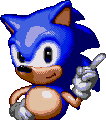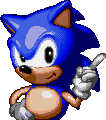Prerelease:Sonic the Hedgehog CD (2011)
This page details pre-release information and/or media for Sonic the Hedgehog CD (2011).
Contents
Retro Sonic
Retro Sonic was a fan game project by Christian "The Taxman" Whitehead which would, later on, become the Retro Engine. The engine, along with creating a nearly-accurate recreation of the Genesis games' physics, also incorporated elements that would be present in future Taxman Sonic projects; namely a variation of Knuckles Chaotix's Combine Ring, which would later be added and updated in Sonic Mania as the Hyper Ring.
The earliest incarnation of this game was created using Multimedia Fusion. Quickly realizing MMF's limitations, Taxman ported the engine over to Visual Basic which, along with the usage of the Direct X API, resulted in a better performance and allowed for more graphical effects akin to what the Genesis and Sega CD could pull off.
First Version
On March 20th, 2002, Taxman released the first demo (so early, that the engine didn't even have a name yet), which included a few playable Zones: Egg Garden Zone, Dust Hill Zone (Past and Present; based on screenshots of a scrapped Zone from Sonic 2 named Sand Shower Zone), and Warehouse Zone. Along with these Zones, a Special Stage (of which the idea of automatically running and collecting Blue Spheres while avoiding bombs would be overhauled and revisited for Sonic Mania, a future Taxman project) was also included.
This time, the engine was rewritten into the C++ programming language using the existing code present in the Visual Basic version. Now recreated from scratch, the newest incarnation was made to be much more flexible, allowing for it to be ported easily to other platforms.
Second Version
On July 10th, 2006, Taxman showcased a proof of concept that showed Retro Sonic running on the Dreamcast. One year later, on August 13th, 2007, a Windows demo of the game was released for that year's Sonic Amateur Games Expo. It featured an updated Egg Garden Zone, an overhauled Special Stage (recreating the layout of the Special Stage seen in Sonic CD's 510 Prototype) and a custom rebuild of Sonic 2's Emerald Hill Zone.
This version of the engine, named "Retro-Sonic C++ Engine Version 2", was utilized for the development of this particular demo. Knuckles was also added as a playable character, along with the ability to pair different characters together, which would later be added to the Sonic 1 and Sonic 2 remasters. In this version, the “Mode 7” effect appears for the first time in Egg Garden Zone and the Special Stage, recreating similar effects from the original versions of Sonic CD.
Sega, Whitehead and Touch Arcade
July 27th, 2009: Sega announces to interested iPhone and iPod Touch gamers the chance to suggest potential iOS ports of games released for their classic systems:
Any idea is welcome, no matter how out there or random, we’ll take it and add it the list for the presentation. There are some restrictions, but that’s expected, right?
- First, it has to be a Sega game, meaning no other publisher’s titles, even if they did appear on our old systems (I know, I know, I want to see a Road Rash sequel too).
- Second, we can’t accept original game ideas, we’re not looking for acquisitions for new titles in this brainstorming session. And that’s pretty much it, go to town and tell us what you want to see.
— Blog Sega
July 28th, 2009, 12:17 A.M.: Christian Whitehead tweets at SEGA, suggesting himself to develop an iOS port of Sonic CD.[1].
@SEGA
http://www.christianwhitehead.com/soniccd/view.html* This is what you should do for the iPhone, that is all, you know who to call...— Christian Whitehead
(The link now redirects to the Evening Star Studio website)
July 29th, 2009: Christian Whitehead tells Touch Arcade about his engine, which is now officially titled the Retro Engine, showcasing the RSDK (Retro Software Development Kit), and suggests that SEGA port Sonic CD, be it with his engine or otherwise.
- In the second screenshot, you can see that the script (R1_TitleCard.txt) looks different: it does not mention the U.S. OST, it uses the .mp3 format instead of .ogg, and all four tracks currently implemented for the JP OST simply loop instead of utilizing the loop cycles used in the final port.
| Proto | Final |
|---|---|
sub ObjectStartup
LoadSpriteSheet("Global/Display.gif")
switch Object[24].PropertyValue
case 0
SetMusicTrack("R1A.mp3", 0, true)
break
case 1
SetMusicTrack("R1B.mp3", 0, true)
break
case 2
SetMusicTrack("R1C.mp3", 0, true)
break
case 3
SetMusicTrack("R1D.mp3", 0, true)
break
end switch
|
if Options.Soundtrack == OST_JP
switch HUD.CurrentTimePeriod
case TIME_PRESENT
SetMusicTrack("JP/R1A.ogg", 0, 142428)
break
case TIME_PAST
SetMusicTrack("R1B.ogg", 0, 354890)
break
case TIME_GOOD_FUTURE
SetMusicTrack("JP/R1C.ogg", 0, 142902)
break
case TIME_BAD_FUTURE
SetMusicTrack("JP/R1D.ogg", 0, 1)
break
end switch
else
switch HUD.CurrentTimePeriod
case TIME_PRESENT
SetMusicTrack("US/R1A.ogg", 0, 153038)
break
case TIME_PAST
SetMusicTrack("R1B.ogg", 0, 354890)
break
case TIME_GOOD_FUTURE
SetMusicTrack("US/R1C.ogg", 0, 152346)
break
case TIME_BAD_FUTURE
SetMusicTrack("US/R1D.ogg", 0, 774998)
break
end switch
end if
|
December 28th, 2009: The Touch Arcade YouTube channel showcases a concept demo of the Sonic CD Taxman port being played on Whitehead's iPod Touch, in which only the first act of Palmtree Panic is present.[2] The port is not a direct emulation of the original Sega CD version, but rather it was developed from scratch using Whitehead's Retro Engine. He then contacted Sega to tell them about his release plans. Thanks to these efforts, SEGA took his request and entrusted him with porting the game to mobile devices, as well as consoles.
The trailer provided for Touch Arcade showcases an early test build, so there are some differences. Here are the most notable:
- The UI throughout the trailer is very different, lacking a pause button and featuring separated D-Pad controls as opposed to the final version's pixelated recreations of the control icons from the original iOS ports of Sonic 1 and 2. The jump button in this build is the most different, featuring an icon of Sonic jumping, rather than the simple A button design.
- The prototype control icons are actually still in the files, under Items2.gif. This includes a Tails version, suggesting that either Tails was always planned to be playable, or these changes were made late into the final version's development.
| RAW | Proto (Restored) | Final |
|---|---|---|

|
- The app icon seen at 0:58 is a cropped version of the EU cover of the Sega CD version, while the startup screen is an obvious placeholder, using a render from the JP PC release's box art, but with some text describing the version of the demo. Interestingly, the Sonic CD logo used here is taken from the EU PC release of the game.
- The SEGA logo at 1:08 is pixelated, unlike the final version which utilizes the regular logo. The version of Sonic CD in Sonic Origins reinstates this early logo design.
- The title screen in this build uses the Sonic sprites from the Windows 95 port, most notable in the redrawn eyes. The final version would use a combination of the Windows 95 body and the Sega CD head.
| Windows 95 / Proto | Final |
|---|---|
- The camera (most notable at 0:12 and 1:41) scrolls forward just like the Sega CD and PC versions. This was most likely removed due to the increased screen resolution.
- At 1:51 and 2:13, the game pauses for a brief moment due to music loading, due to this using an earlier version of the Retro Engine.
- The item icons do not fade out after hitting the monitors like in the final version, instead just disappearing like the original game.
- At 4:03, the signpost is not in the center, instead being slightly to the right.
Mid-2011: Taxman posts an update on his blog, stating that he had become busy working on a title set to release later that year, which was later revealed to be the 2011 port of Sonic CD. The port was made using an updated version of his Retro Sonic engine, just like his proof-of-concept build.
August 25th, 2011: SEGA tells GamesRadar that Sonic CD will be coming to every modern platform at the time, except for WiiWare, citing Nintendo's strict 40MB file size limit being unable to fit the CD quality sound as the reason.





